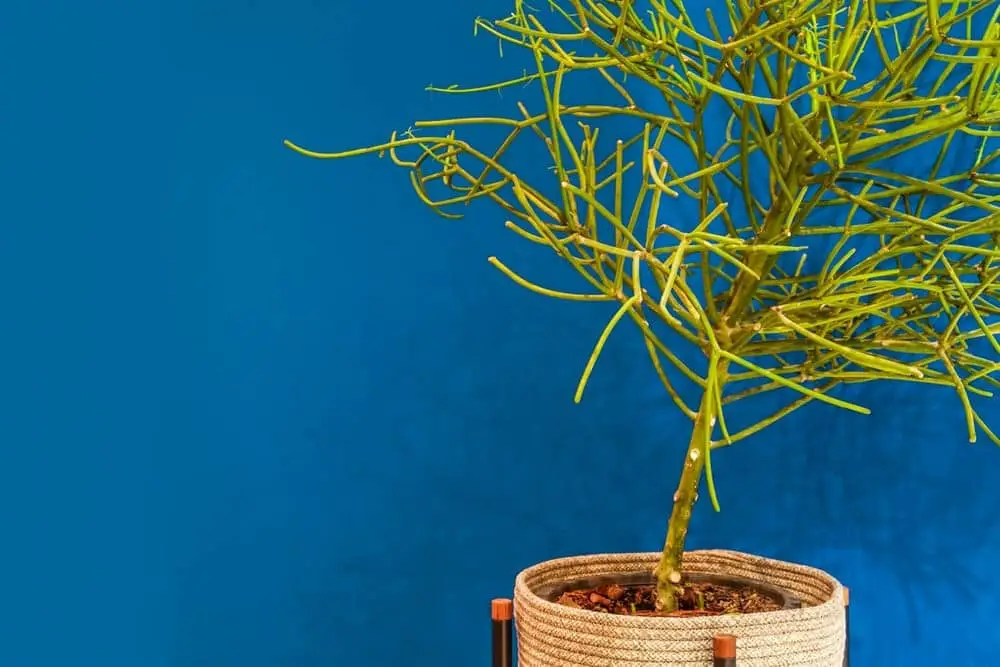The Pencil Cactus plant is native to both India and South Africa. Also called Milk Bush, this plant is both aesthetically pleasing and easy to care for.
There are, however, a number of tips and instructions to follow when caring for it.
Pencil Cactus Plant Care & Growing Guide
1. Light Requirement
This cactus plant needs to be kept in bright, direct sunlight during the afternoon. It is important to keep in mind that these plants cannot survive let alone thrive in shady areas. If you want to keep your plant strong, you’ll need to give it lots of bright sunlight each day.
If you are going to keep one of these plants indoors, you should place it by a window that faces, south, east, or west. This will ensure that it gets all of the sunlight it needs to grow normally and stay healthy over the long term.
2. Water
Before you water your Pencil Cactus plant, you’ll need to make certain that it is not already moist. This plant’s soil should be at least fairly dry an inch down before you give it a drink. These plants are extremely drought tolerant, so you don’t need to water them very often.
Overwatering is a big issue with this cactus plant. If you keep watering this plant before the top layer of soil dries up, it will inevitably develop root rot. You never want to water it until the soil looks and feels dry.

3. Climate
Pencil Cactus plants are native to dry, arid regions of the world. They can be grown in USDA hardiness zones of 9A through 10A. They don’t do well in very humid tropical climates. If you live in such a region, you’ll probably want to keep your plant indoors.
4. Soil
It is best to use gritty soil that drains well for the Pencil Cactus plant. If the soil you put this plant in doesn’t drain adequately, root rot becomes a real possibility.
You can also use fertilizer, but it isn’t that important for normal growth. A good quality liquid fertilizer is appropriate for these plants. Cactus soil is ideal for this plant, so you’ll want to keep that in mind as well.
5. Temperature
These plants tend to do best within a strict temperature range of 65 to 70 degrees Fahrenheit. They can tolerate slightly higher temperatures, but not colder ones. In fact, it is impossible to keep this plant alive when temperatures drop below 50 degrees Fahrenheit.
6. Repotting
It is a good idea to repot this plant every two to three years. You won’t have to worry about doing this as often as with most other houseplants. When you do repot this plant, make sure that you put it in a container that is a couple inches wider. This will allow the roots to spread out without any issues.
If you want to keep the plant in the same container, you can simply replace the soil every so often and trim the roots as well as the foliage. It is best to repot in the summer or spring months. Repotting at other times of the year increases the risk of severe damage to the plant.
7. Speed of Growth
These plants grow their fastest when they are given lots of bright, direct sunlight on a daily basis. They do not grow quite as quickly as many other houseplants.

8. Height and Spread
This cactus plant can grow up to 30 feet and three feet wide. It is recommended that you leave anywhere from six to eight feet of spacing between plants. This will help a lot with preventing problems with tangled roots.
9. Trimming
You will need to occasionally trim the Pencil Cactus plant, removing any dead foliage. One of the great things about this plant is that you won’t have to worry about pruning to maintain its shape. You should never take more foliage off the base than necessary. Make sure all of the top growth stays intact.
More like this: Coral Cactus (Eurphorbia Lactea Crest) Care & Growing Guide
Is the Pencil Cactus Plant Poisonous?
It is important to keep in mind that the Pencil Cactus Plant is very toxic to both humans and pets. If you have one of these plants around the house, you’ll want to be careful about where you keep it. It can have a severe toxic effect when even a relatively small amount is ingested.
Make sure that you also exercise caution when pruning this plant, as the sap is toxic and can cause an adverse skin reaction. You can avoid this by simply wearing gloves whenever you need to handle the plant.
Common Pencil Cactus Plant Diseases
Mealy bugs can be an issue with these cactus plants. You can reduce problems with these pests by simply applying a deterrent product of some kind. If you notice a white substance on your plant, you most likely have these bugs.
Root rot is another common disease that affects this plant, and it can be avoided by simply not over watering. Make sure that you wait until the plant’s soil is dry between waterings. It’s also important that you keep the plant in well-draining soul.
Also read:
Conclusion
- The Pencil Cactus plant requires bright, direct sunlight throughout the afternoon.
- If you keep this plant inside, make sure that you keep it by a west, east or southern-facing window.
- Always wait until the soil is dry before watering.
- Gritty, well-draining cactus soil is best for this plant.
- This plant does best when it is kept within a temperature range of 65 to 70 degrees Fahrenheit.
- These plants are native to dry, arid regions of the world, which is the type of climate they do best in.
- You’ll only need to report these plants every couple of years. Make sure the container you use has is about two inches larger.
- Remove dead foliage from this plant when necessary. You won’t have to prune it to maintain its shape.
- Mealybugs can be a problem with these plants, but they are easily removed.

Victoria is the owner and main author of hobby plants. She loves spending her free time in her garden planting and taking care of her plants. Victoria hopes you enjoy the content here!
![Mother Of Thousands Plant [Complete Plant Care Guide] Mother Of Thousands Plant [Complete Plant Care Guide]](https://www.hobbyplants.com/wp-content/uploads/2022/07/mother-of-thousands-plant-300x158.jpg)
![Majesty Palm Plant Care: [Complete Beginner's Guide] Majesty Palm Plant Care: [Complete Beginner's Guide]](https://www.hobbyplants.com/wp-content/uploads/2022/08/majesty-palm-care-300x158.jpg)
![Exotic Angel Plant Care: [Complete Beginner's Guide] Exotic Angel Plant Care: [Complete Beginner's Guide]](https://www.hobbyplants.com/wp-content/uploads/2022/08/exotic-angel-plant-care-300x158.jpg)
![Snow White Waffle Plant: [Complete Care Guide] Snow White Waffle Plant: [Complete Care Guide]](https://www.hobbyplants.com/wp-content/uploads/2022/08/snow-white-waffle-plant-300x158.jpg)
![Waffle Plant Care: [Complete Beginner's Guide] Waffle Plant Care: [Complete Beginner's Guide]](https://www.hobbyplants.com/wp-content/uploads/2022/08/waffle-plant-300x158.jpg)
![Bird Of Paradise Plant Care: [Complete Beginner's Guide] Bird Of Paradise Plant Care: [Complete Beginner's Guide]](https://www.hobbyplants.com/wp-content/uploads/2022/08/bird-of-paradise-plant-300x158.jpg)
![Purple Passion Plant Care: [Complete Beginner's Guide] Purple Passion Plant Care: [Complete Beginner's Guide]](https://www.hobbyplants.com/wp-content/uploads/2022/08/purple-passion-plant-care-300x158.jpg)
![China Doll Plant Care: [Complete Beginner's Guide] China Doll Plant Care: [Complete Beginner's Guide]](https://www.hobbyplants.com/wp-content/uploads/2022/09/china-doll-plant-care-300x158.jpg)
![Polka Dot Plant Care: [Complete Beginner's Guide] Polka Dot Plant Care: [Complete Beginner's Guide]](https://www.hobbyplants.com/wp-content/uploads/2022/09/polka-dot-plant-300x158.jpg)
![Mona Lisa Lipstick Plant Care: [Complete Beginner's Guide] Mona Lisa Lipstick Plant Care: [Complete Beginner's Guide]](https://www.hobbyplants.com/wp-content/uploads/2022/09/lipstick-plant-mona-lisa-300x158.jpg)
![Yucca Cane Plant Care: [Complete Beginner's Guide] Yucca Cane Plant Care: [Complete Beginner's Guide]](https://www.hobbyplants.com/wp-content/uploads/2022/09/yucca-cane-plant-care-300x158.jpg)
![Bush On Fire Croton Plant Care: [Complete Beginner's Guide] Bush On Fire Croton Plant Care: [Complete Beginner's Guide]](https://www.hobbyplants.com/wp-content/uploads/2022/09/bush-on-fire-croton-300x158.jpg)